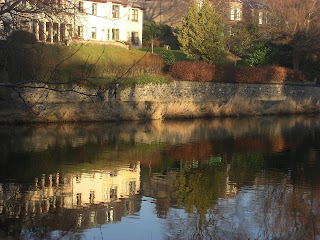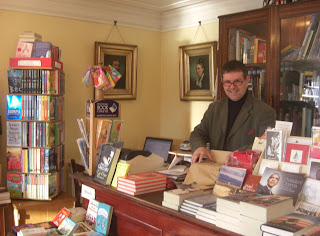 The plain grey building, third from the right, is probably the oldest, dating back to maybe the 17th century, while probably the white building is the most recent. I'd say it has a look of 1930s Art Deco to it. To the right of the grey house, the creamy coloured building has a carved stone plaque on the wall, indicating that this was once a bakery. In fact, the baker's ovens are still in existence to the rear of the building, in a present day tearoom, called the Oven Door, through the doorway and along the passage between the jewellers and the fish'n'chip shop. Click to enlarge and you'll see it better.
The plain grey building, third from the right, is probably the oldest, dating back to maybe the 17th century, while probably the white building is the most recent. I'd say it has a look of 1930s Art Deco to it. To the right of the grey house, the creamy coloured building has a carved stone plaque on the wall, indicating that this was once a bakery. In fact, the baker's ovens are still in existence to the rear of the building, in a present day tearoom, called the Oven Door, through the doorway and along the passage between the jewellers and the fish'n'chip shop. Click to enlarge and you'll see it better.The narrow bow fronted building with the triangular top and red tiles is strange and doesn't strike me as being very Scottish in style. Further along the High Street and into Eastgate (off to the right of the photo) is a double version of the same style. Above the Medical Hall on the right, the upper floor window pediments have some pretty decoration, but what I am annoyed at myself for missing out is a large sundial on the wall just out of shot. Another day, another photo then!
The street is seldom empty of cars. During the evolution of the town to what it is today, cars only made an appearance in the late 19th century, so no provision was made for the then unforeseen horseless carriages of the future. Car parking space is now at a premium which is why there are always cars on the High Street.































